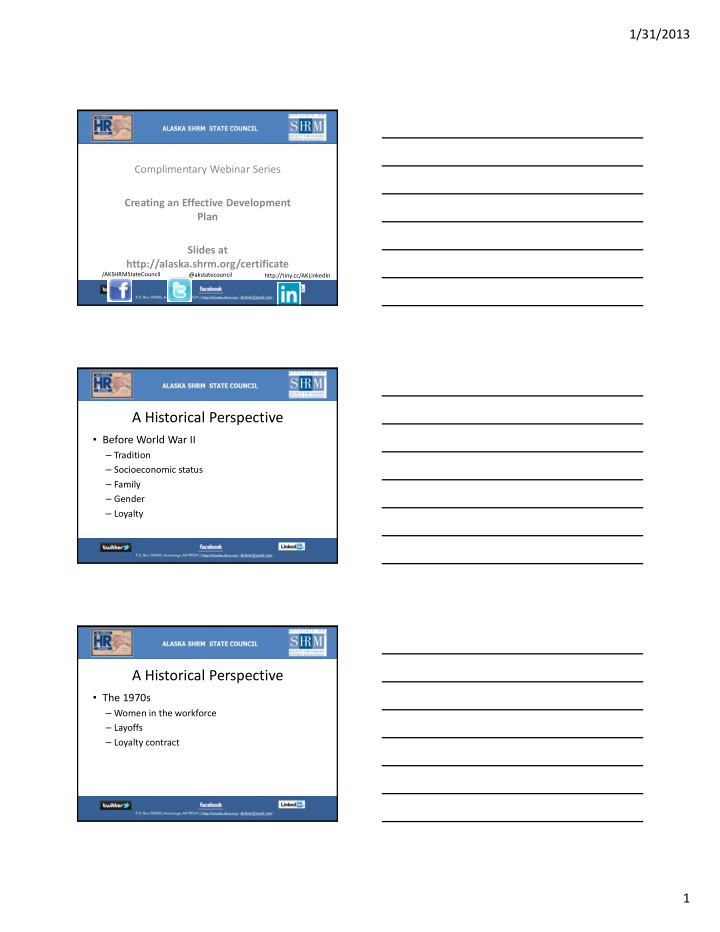



1/31/2013 Complimentary Webinar Series Creating an Effective Development Plan Slides at http://alaska.shrm.org/certificate /AKSHRMStateCouncil @akstatecouncil http://tiny.cc/AKLinkedIn A Historical Perspective • Before World War II – Tradition – Socioeconomic status – Family – Gender – Loyalty A Historical Perspective • The 1970s – Women in the workforce – Layoffs – Loyalty contract 1
1/31/2013 A Historical Perspective • Today – Economic competition – Globalization – Skills, education and training – Technology – self ‐ directed, lifelong learning A Historical Perspective • Great Recession – High unemployment rates but hard to fill high ‐ skilled jobs – Added jobs ‐ mix of new skills or skills entirely different – Increased emphasis in talent management and employee development Business Case • Develop employees or find new ones? • Benefits of Employee Development – Remaining competitive. – Dealing with ongoing skills shortages. – Taking employee development “off hold.” – Adapting to changing business structures. – Increasing worker productivity – Reducing turnover – Aligning employee development with the organization’s needs 2
1/31/2013 HR’s Role • Employees manage their own career development • HR ensures that the organization provides ways for employees to be more effective in their current roles • HR shows benefits of development • Rules to help HR align employee development with the organization’s talent management strategy: – Know the organization well – Know the needs of employees – Know the industry – Know how to quantify outcomes Guidelines for Effective Dev Plans • Gain executive support • Involve management • Relate to performance management • Understand what the employee values • Know the desired outcome What is an EDP? Documented Plan That Helps Employees • Learn new skills • Increase engagement in current position • Prepare for current and future roles • Build internal talent • Adapt to organizational changes • Become prepared for future opportunities 3
1/31/2013 Career Development Vs. Performance Management Career Development: Looking forward –what future experiences and skills do I want to acquire? • New role • Challenging assignment • Leadership role aspirations Performance Improvement: Looking back –what can I learn from past experiences • Prior period rating • Improve in current job • Get up to speed as a new employee • Improve current skills When is an EDP utilized? • Importance of timing • Process Training Career Competency Needs Development Development Analysis Planning Will all employees need an EDP? It will depend on the situation: • Personal aspirations • Ongoing dialogue Everyone can and should be learning something new. We never stop improving . Learning is growth, and growth is healthy. 4
1/31/2013 Budget RESOURCES • 70 ‐ 20 ‐ 10 Process 10% Formal Training 20% Relationships/Networks 70% Challenging Assignments and OJT • Educational Assistance Policy • Shareholder Training and Development Resources Creating an EDP Create your Development Plan Conduct a Gap Analysis Pre-Planning Career Development Process Execute Approvals Discussion Manager Review Planning 5
1/31/2013 Employee Development Methods Coaching • • Mentoring • Individual development plans • The 9 ‐ box grid • Cross ‐ training • “Stretch” assignments and On the Job Training • Job enlargement and job enrichment Job shadowing • • Job rotation • Succession planning • Etc Common Challenges • Accountability Gaps in talent development capabilities • • Lack of alignment between human capital and business strategy • Inconsistent execution Limited use of meaningful analytics. Few employers track the metrics that matter, • such as the effectiveness of talent management programs. • Funding challenges – Analyze and prioritize – Determine what is essential – Cut back creatively – Tap free resources • Diversity considerations • Generational issues Communication • Expectations • Eligibility • Opting out of development • Identification of “high potentials” 6
1/31/2013 ROI • http://www.shrm.org/Education/hreducation/Pages/ReturnonInvestmentTrainingandDevelopment.aspx Resources • http://www.shrm.org/hrdisciplines/orgempdev/articles/Pa ges/AccountabilityCapabilityChallenges.aspx • http://www.shrm.org/Publications/hrmagazine/EditorialCo ntent/Pages/0109train.aspx • http://www.shrm.org/hrdisciplines/technology/Articles/Pa ges/CMS_006596.aspx • http://www.shrm.org/Research/Articles/Articles/Pages/Em ployee_20Testing_20Series_20Part_20III_20 ‐ _20Assessment_20Tools_20and_20Centers.aspx • http://www.shrm.org/templatestools/toolkits/pages/engag inginsuccessionplanning.aspx Resources, Cont. • http://www.shrm.org/TemplatesTools/hrqa/Pages/Whatisjobrotatio n.aspx • http://www.shrm.org/publications/hrmagazine/editorialcontent/pa ges/0908hragenda_tyler.aspx • http://www.shrm.org/hrdisciplines/orgempdev/articles/Pages/Indiv idualDevelopmentPlans.aspx • http://www.shrm.org/hrdisciplines/orgempdev/articles/Pages/Mak eMentoringPay.aspx • http://www.shrm.org/Publications/hrmagazine/EditorialContent/20 12/0612/Pages/0612moss.aspx • http://www.shrm.org/hrdisciplines/orgempdev/articles/Pages/Lifel ongLearningAccounts.aspx 7
1/31/2013 HRCI ‐ Pre ‐ approved General Credit Thank You! To download a copy of your certificate and slides go to http://alaska.shrm.org/certificate 8
Recommend
More recommend